 |
|||||
Older Blog postsHow Long Did It Take You To Do That"? Quite a while ago I saw a show on TV, where an interviewer was wandering around on one of Sydney's northern beaches and talking to people. He chatted to an old guy who had an easel set up and was doing a landscape painting of a rocky headland. In response to a question about what bystanders ask him about his work, the artist said that the number one question was "how much does it cost?", quickly followed by "how long did it take you to do that?" The artist came back at them with a reply that I remember clearly. "About 35 years" More....................Painting, Cutting In and Drop Sheets - Aug 2 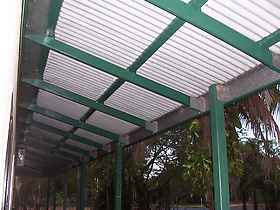
Over the last week or so I have been painting my outside verandah eaves. I have a verandah that runs all around the house and the eaves are not lined, but open, so I have had to paint the exposed rafters and ceiling battens. Cutting in at the edges of the battens up against the underside of the roof sheeting has been a pain in the proverbial. After struggling for a while, I had a brainwave, that has improved my accuracy and performance tenfold.More.................... A bit of gratuitous rambling on trade secrets. Aug 29 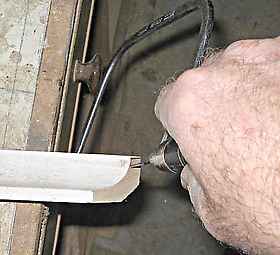
I have just added another page about coping saw work . read the full blog post25th July, Deck Supports or Stumps 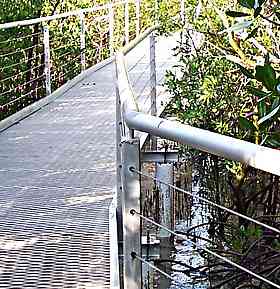 The other Sunday morning I did one of my
rambling slow bike rides. I finished up as I
almost always do, along the coast. The spot
along the coast that I went to had one of our
many boarded walkways out into the
mangroves.
The other Sunday morning I did one of my
rambling slow bike rides. I finished up as I
almost always do, along the coast. The spot
along the coast that I went to had one of our
many boarded walkways out into the
mangroves.I love pottering about in the mangrove swamps as they are sometimes called. They are magic places, full of life. When I walked out onto the boardwalk where the tide was running in quite fast, I saw a splash ahead in the surprisingly clear water, and waited a while. Sure enough a small stingray about the size of a dinner plate cruised along among the mangrove roots in the shallow water. Magic, it made my morning. Read the full blog post July 19 Chemical Fastners, the Chemset Injection System 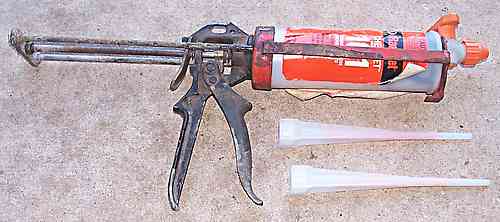 Talking about fixing bolts into masonry with epoxy the other day, got me thinking about another method. The Ramset "Chemset" injection system. I have used this a lot, partly because it is specified, that is the engineer gives no alternative, but quite often I use it because it is so quick and convenient. It is an excellent way of fixing bolts into walls, because unlike mixing up your own epoxy mortar, it is a self contained system that uses polyester resin, which takes on it's initial set fairly quickly. Read full blog post July 14 Mixing EpoxyYesterday I mentioned epoxy. We use it a lot in building works. Grouting in bolts is probably the most common.Once upon a time, I mixed up about 3/4 of a liter of liquid epoxy in a milk carton. I carried it up some steps and into a roof space, were I started to pour the stuff into previously drilled holes and to drop in hold down bolts, for a cyclone upgrade job. The stuff started to get warm, then hot, and by the time I had managed to throw the carton away from me the epoxy was foaming out of the carton. A term used in the fiberglass industry is "a hot mix". Meaning one that sets quickly. This one was a hot mix alright. It could have had a touch too much hardener, but the main reason for the exothermic reaction was the container I was using. When it is in a compact mass it generates heat, which accelerates the setting. So I should have mixed the same amount and then put it into something like a flat tray, when spread out the reaction does not occur as quickly. The reason I like using clean milk cartons for mixing is that apart from being readily available and throw away afterward, is that they have parallel sides. This makes it easy for measuring the volume ratios. If I put a pencil mark on my mixing stick say 1" up from the bottom, and then another say 4" up I can put hardener in to the 1" and epoxy to the 4" marks and I have a 3:1 ratio. This won't work with tapered sided or rounded bottom containers. Solvent DangersAnother aspect of the oily rag post.When I was doing a couple of courses on printmaking a few years ago at our local uni, the big thing was water based printmaking. There has been a reaction against using oil based inks. I should say, the reaction is against the solvents used for cleaning etc. not the inks themselves. Inhilation of solvent fumes has been known for many years now as a health hazard. For etching the thick viscous oil used in the inks is still the best, but what was happening, those of us who preferred to clean our plates with mineral turps were sent out into the open air, (a bit like cigarette smokers today) and we had a table set up under a tree. (it was great actually). The others who were more aware or worried about the dangers of the solvents cleaned their etching plates with ordinary cheap vegetable oil. It took them a lot longer, but they were not subjected to the fumes that we were. I did a couple of jobs quite some years ago, that involved a large amount of epoxy work. We were pressure injecting cracks in concrete, using epoxy mortar and coating concrete with epoxy. All my reading at the time lead me to believe that the epoxy materials themselves were fairly benign, but it was the solvents that were potentially very dangerous. My advice to anyone using solvents is to be very careful. Use good quality masks when using highly volatile thinners and solvents. Back to my original topic of using full gloss enamel paint inside a house. In my opinion, the wearing characteristics and looks of oil based can't be beaten, but I guess it is getting used less and less in ordinary house renovation work as more people opt for safety rather than other considerations. A big plus with acrylic paints is the easy clean up. Water, and then warm soapy water. July 12 - Oily Rags and Spontaneous CombustionAs I have said, this week I have been painting doors and jambs with full gloss enamel paint. There is always a bit of cleaning up with mineral turps soaked rags and yesterday I found a couple bundled up under my work bench. This is a bit of a no no. I should know better than to leave oily rags about. I have never seen it happen, but it is possible for oily rags loosely packed in a confined area to spontaneously combust. I could have caused a house fire.I have seen, first hand the effects of spontaneous combustion. When I was about 17, I was doing maintenance type work in a spinning mill. This was in the days when Lancashire had a cotton industry. I head a soft whump and then an enormous blast. The cotton dust in the air had exploded. No one was hurt, but the blast took out a large section of the glazed Northern Light roof and did a medium amount of other damage. The factory's own fire team seemed to have the area cleared of workers, the fire contained and then out, in what seemed to be just a few minutes. Obviously a well practiced routine for a very real danger in the mills of that era. I once went down a coal mine, in Staffordshire and I remarked that the timber boarding over the ceiling of the tunnels was a bit loose. The old guy showing us around explained that it was an technique of Polish miners who took it over to the UK after the second world war. They fitted loose boards above the ceilings with some sort of dry powder on top. When an explosion occurred the pressure wave dumped the loose powder into the air which stopped the explosion spreading further. What with the mills and the mines, it's no wonder I chose to be a carpenter. July 11 Two Men, One Demountable Building, No Crane, No Problems.One of the best examples of using a low tech solution to a problem that I have ever seen, was many years ago at Wattie Creek (Daguragu).I have moved this and the answer to my new Low-tech solutions page. July 10 "Fox Wedges" or Folding Wedges. Wedges in Pairs.This is another one that I have expanded and moved to my Low-tech solutions page.July 7 Painting doors and door jambs.I have been doing quite a bit of painting recently. I asked my old mate Holmsey (a painter of 40 odd years, "man and boy" as he says), for a few general guidelines. To cap it off he even advised on colours. I am tidying up our house, doing all the things I said I would do 10 years ago when we bought it. This with a view to selling it and moving on. His advice was to keep the colours bright and neutral.I was going to paint my skirtings (baseboards) along with the door jambs and architraves, in a contrasting colour to the walls. "Don't bother" he said, "just paint them in with the walls, it's a lot easier, and because the rooms are all fairly small, a darker skirting will make them look smaller still". I think he was right about the looks of it, and it was certainly a lot easier. He came around one day when I was glossing the door jambs and architraves with full gloss enamel oil base paint. "You've got a run there!" "Where? No way!" "There." "No, no, that's not me, that's from the last time it was painted." "Doesn't matter, you're painting it now, you should have sanded it down before you started. Another thing, stop dabbing about, long strokes, keep it moving and keep that wet edge." "Get out of here! Stop looking over my shoulder, go and make yourself a cup of coffee." He was right of course, the secret of a good paint job is preparation, I should have done more. The secret of a good gloss job is to get it on fairly quickly and neatly and don't go back over it once it has started to firm up, the paint tends to pull and pluck, and when it's dry the shine is not the same. I was quite happy with the results I got out of painting the doors. I used the paint straight out of the can, and applied it with a 6mm natural Mohair roller. As soon as the face was done, I laid it off with a 100mm brush. That is, with long sweeping very light strokes I took the bubbles and orange peel effect from the surface that was left by the roller. April 14 Mast High Waves and GoogleWhen I was a youngster (early forties) I took up windsurfing. After a few years experience we had a family windsurfing holiday traveling down the W.A. coast. I can distinctly remember the time in Lancelin heading out to the break on a really good day (over mast high waves, say 16ft), I was watching a guy approaching me on a wave, the stuff of magazine photos, when suddenly it hit me. "Bloody hell.....I must look like that". I just couldn't believe that I could be doing that stuff until that instant. (Actually I might not have done it too long, as it could have been the day I broke my board in half:-). Anyway, I had the same feeling this morning when I fired up my site and saw my first Google Ads on my power tools page. Disbelief that an old fart like me can get something up and running like a functional web page. How the heck I did it still amazes me. My wife SWMBO does crosswords and Sudoku puzzles to keep her brain ticking over, for me it's this web site. It is very challenging, but the help out there is incredible and I feel a touch of satisfaction to think I am starting to do my bit. If you have ever thought about making a web page, I'd say go for it. It's so much fun. Of course I've had it fairly easy as I have had this mob giving me a hand. April 12 Have YOU found a dihedral angle?I have just added a new roofing page with a description of how to find a dihedral angle. Not many people have found one, cos they're shy little things, they hide under names like valley gutter angle, and hip backing angle, but once you've found one you can join a select club :-)April 11 Crown moulding angles on a compound miter sawI have had a question from Jan R. in Canada about crown moulding angles on a compound miter saw. I have no experience with the saws, but I've cut few few angles in my time, so I have added a few paragraphs in mytrim carpentry page. April 10 Wet area plasterboard-drywall? No way.Yesterday I had a chat to a couple of plasterboard (drywall) fixers and flushers. I remarked on the fact that they were fixing wet area plasterboard in the bathrooms and wet areas in general, instead of the Hardies cement sheet (blue board) that obviously does the job a lot better in the long term. This was on houses for the Defense Housing Authority (Australia). DHA has a reputation for building quality houses, and the standard of supervision and the workmanship I have seen in the construction is excellent. Except for this. No one will convince me that plasterboard has a place in bathrooms. I wouldn't even use it on the ceilings. The guys themselves admitted that they wouldn't do it in their own homes. So why do DHA do it? I've no idea. I believe in Murphies law, s**t can and does happen. I built a house for CSR (Building materials manufacturer) at the same time I was building my own. I got conned into using one of their products on my place. High density chip board flooring. Great to fix and work with, 9ft x 6ft sheets. Houses are always dry, no probs with chipboard. Shit happens. Cyclone Tracy lifted my roof. After a couple of weeks in a Darwin wet season the floor disintegrated. Expensive parquet an all. If I had have used Jarrah T&G it would still be here. April 9 "I enjoy what I do"This morning I have had an encouraging note from Michael in NY State, and one of the things he said really struck a chord with me. he is a master carpenter of 31 years standing and he said,"I have done concrete stairs for the State of NY and its never an easy build But I enjoy what I do and that makes the hardest things easier". "I enjoy what I do" Well said! It has been my secret to a happy life, that's for sure. I used to do a lot of work at a high school a few years ago and one thing that struck me was the push towards computer labs etc. This place had a fully fitted out metalworking shop, lathes, welding booths etc. It has been unused for ten years now. The woodworking class was very small and just hanging in. It may also be closed down now. No more manual skills training. The school system and the media seem to be pushing young people into higher and higher job expectations. I was glad to get an apprenticeship, I am lucky to have been totally suited to the work I have done. (My opinion, You will have to ask my customers for the real answer :-). A young guy similar to Michael or myself will probably be doing something like IT or Business Management at university now. Struggling and probably looking forward to a working life of dissatisfaction. I have said many times to young guys working for me, "It's better to be near the top of a lower field than near the bottom of a higher one. I guess that one of the main reasons for the popularity of DIY is that feeling of satisfaction of a job is well done, because a lot of folks today don't ever get that feeling from the work they do. Crikey, I do rave on don't I, mind you that is required in a blog, isn't it? See ya later. May 28 Valley lengths and anglesI have had a visitor to the site searching for "Valley lengths and angles". This made me realise that I have not mentioned valleys in my roofing page. The geometry of hips and valleys are identical, (in the same even pitched roof) but the actual physical position in relation to the roof surface is lower. I will do a quick sketch to illustrate this and put it in the page ASAP. (Fixed now, see this page.) May 7 Fixing loose screwsI fixed my bathroom door yesterday.
I can't put in bigger screws and longer ones were no good also. It appears to be a Meranti door jamb (soft timber) and I was pondering on how to give the screws more grip. I thought of plugging the holes up with Builder's Bog, yeah that's right Bog not blog. This is a polyester type filler like "Plasti-Bond". Sets in about 20 minutes and they saw you can screw to it. Then I hit on the idea of plastic wall plugs. I dug out some white ones, which are about 4mm dia. and gave it a try. Great! The screws gripped really solid, just like if they were back in new timber. I had to snip a couple of the plugs shorter but it was easy. If you are into DIY or building and home improvement work, and you are running a blog yourself, give me a yell and I'll put up a link to your blog. Not found it yet? Try this FAST SITE SEARCH or the whole web |
Hire Equipment  Furniture Fittings - Architectural Hardware - Electronic Locking Systems - Technical Hardware BuilderBill sponsorship newer Blog PostsBlog posts on this pageHow Long Did It Take You To Do ThatChemical Fastners July 16 E-Book July 14 Mixing Epoxy Solvent Dangers July 12 - Oily Rags and Spontaneous Combustion July 10 "Fox Wedges" April 14 Mast High Waves and Google April 12 Have YOU found a dihedral angle? April 11 Crown moulding angles on a compound miter saw April 10 Wet area plasterboard-drywall? No way. April 9 "I enjoy what I do" May 28 Valley lengths and angles May 7 Fixing loose screws |
||||
|
some text or whatever.
|
|||||
|
Please Note! The information on this site is offered as a guide only! When we are talking about areas where building regulations or safety regulations could exist,the information here could be wrong for your area. It could be out of date! Regulations breed faster than rabbits! You must check your own local conditions. Copyright © Bill Bradley 2007-2012. All rights reserved. |
|||||
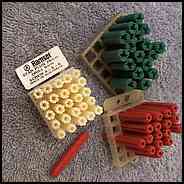 After much on and off during my bathroom
tiling renovation it had just about stripped
all the screw holes, because the hinges were
not loose pin. I should have changed
them, as it would have been a lot easier all
round.
After much on and off during my bathroom
tiling renovation it had just about stripped
all the screw holes, because the hinges were
not loose pin. I should have changed
them, as it would have been a lot easier all
round.